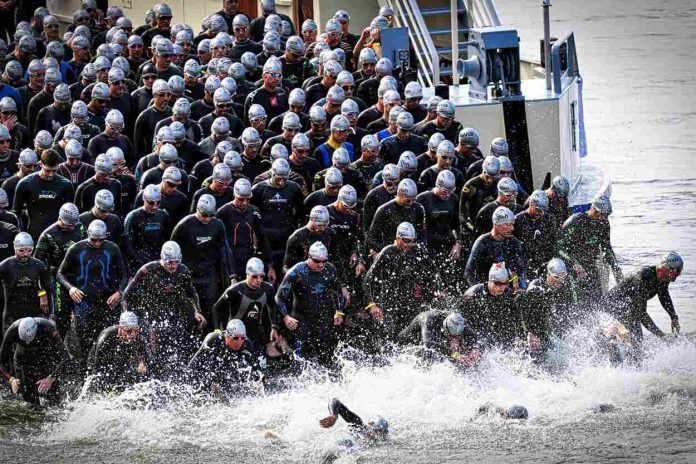Last Updated on August 15, 2025 by Rida Hamid
Need tips on buying a triathlon wetsuits for beginners? Not sure how to go about comparing options for wetsuits?
If you want to do your best in your first triathlon, it’s important that you get a triathlon wetsuits that will help, rather than hinder, your performance. Make sure that you compare your options carefully and consider all of the most important factors when making your choice.
Here are 7 crucial tips you need to remember when buying triathlon wetsuits as a beginner.
Table of Contents
1. Start With the Right Fit
The first step to finding a great triathlon wetsuit is to ensure that you find one that fits properly. The suit should be sized well and there shouldn’t be any air spaces between your skin and the suit.
You need to have a wetsuit that is very snug when you first put it on. Remember that the wetsuit shouldn’t be too easy to get into, but instead should be a bit tight at first. However, make sure that it’s not painful or extremely uncomfortable either.
Once you’re in the water, the wetsuit will feel looser and more comfortable.
2. Consider Feature Options
Many different features are marketed to wetsuit owners, but it’s up to you to decide which of these features are a must-have for you.
Common features may include various types of zippers, built-in hoods, special pockets, and more. Many of these features are unnecessary but can provide extra convenience and functionality for your suit, so it’s worth considering the different options.
High-end suits will be more likely to include useful features, but some features are becoming more common in low and mid-tier suits as well. Be sure to consider the different options and decide whether there are any features that are essential for you.
3. Decide Between Sleeved and Sleeveless
One of the decisions to make when purchasing a wetsuit is whether you want to buy a sleeved or sleeveless wetsuit. A sleeveless wetsuit can add a bit of extra flexibility and range of motion, so it can be easier to swim in.
The decision you make will primarily depend on what temperatures you’ll be swimming in. For water that is over 68 degrees or so, a sleeveless wetsuit may be the better option for you to choose. For colder water, you may want to consider buying a wetsuit with sleeves instead.
Be sure that you consider your own temperature preferences to decide which type of suit to buy.
4. Consider the Range of Motion
Another thing to consider when buying a wetsuit is what its range of motion is. While sleeves can affect the range of motion to an extent, other factors can affect a wetsuit’s range of motion as well.
You’ll want to ensure that the wetsuit you choose lets your arms and shoulders move adequately. The suit shouldn’t pull down on your arms too much and you should be able to do a normal swim stroke with ease. If the suit constricts your movement too much, it can affect your performance and reduce your speed.
5. Know the Wetsuit Fabric
Wetsuits are made out of neoprene, a synthetic rubber that has thousands of small air pockets within it. The small air pockets in the fabric help to encourage buoyancy and also insulate the body as well, helping it to retain heat while swimming.
Keep in mind, however, that there are different qualities of neoprene however and not all of them are the same.
Yamamoto neoprene is considered one of the best options and is thin, light, and warm. This is the type of neoprene that you’re most likely to find in high-end wetsuits. Lower-quality wetsuits will use thicker neoprene that doesn’t offer the same level of quality instead.
Be sure to consider the buoyancy and heat retention of the material in the wetsuit you choose. Consider buying a wetsuit that is made from high-quality neoprene rubber if you want to get the best suit possible.
6. Determine the Quality
You should think carefully about the level of quality you’re looking for when choosing a wetsuit. There are many differences between higher and lower-end wetsuits, so it’s well worth considering which one will be the best choice for you.
Higher-end wetsuits will be made from higher-quality materials and will also have a better balance of rubber thicknesses in different parts of the suit. These suits will be designed with care to give you an advantage in the water. They’ll also come with a lot of other additional features as well.
7. Check the Cost
Part of the choice you make between a low, mid, or high-end wetsuit will be based on the cost. There is a wide range of wetsuit prices, so you’ll need to consider your budget carefully when choosing which suit to buy.
Entry-level options often began around $150 while high-end wetsuits may cost $600 or more. Mid-range options can bridge the gap between the two.
It’s important to look at all of the factors when choosing a wetsuit and ensure that you’re getting the best value possible, no matter how much money you spend. Sometimes entry-level wetsuits can be pretty impressive while sometimes high-end wetsuits can be lacking. Often the mid-range suits are the better option and will offer you a great combination of features, performance, and price.
If you only need a wetsuit for a short period of time, you may also want to consider renting a wetsuit. Be sure to check out this wetsuit rental company if you think that renting may be the best choice for you.
Using These Tips When Buying Triathlon Wetsuits
If you want to make the best decision when buying triathlon wetsuits, you need to consider all of the factors. Be sure to use these tips when making your choice.
In search of more sports and adventure tips? Start browsing our blog now to discover more useful advice.
Read More: 5 Common Types of Florida Work Injuries



























